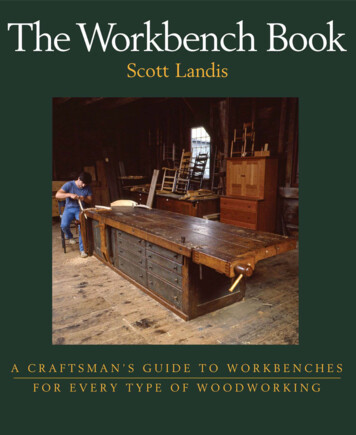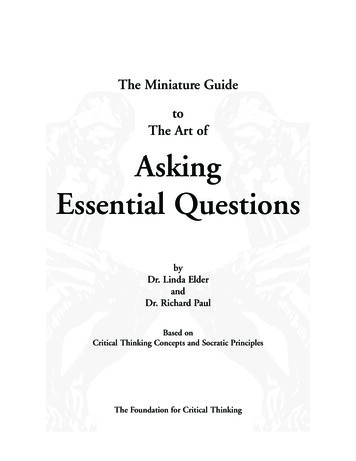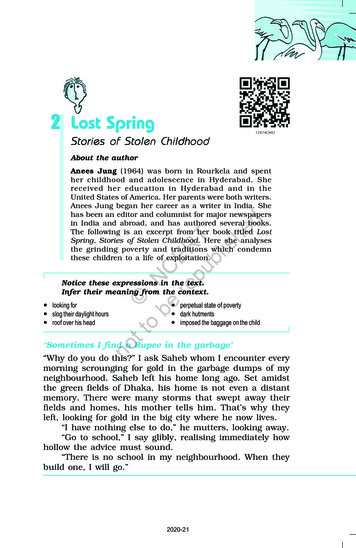
Transcription
TheEssentialWoodworkerThe Essential Woodworker WearingRobert Wearing
Editor: Christopher SchwarzDistribution: John Hoffman, Sharon HoffmanCopy editor: Megan FitzpatrickISBN: 978-0-578-06044-6Original edition published 1988The Essential Woodworker. Copyright 2010 by Robert Wearing.Printed and bound in the United States. All rights reserved. No partof this book may be reproduced in any form or by any electronic ormechanical means including information storage and retrieval systemswithout permission in writing from the publisher; except by a reviewer,who may quote brief passages in a review. Published by:Lost Art Press LLC26 Greenbriar Ave.Fort Mitchell, KY 41017LostArtPress.com
TheEssentialWoodworkerSkills, ToolsAnd MethodsREVISED EDITION WITH MORE THAN 500 ILLUSTRATIONSby Robert Wearing
ContentsIntroduction 61 Basic Woodworking Skills 10Planing 11Sharpening 12Adjusting the plane 17How to plane 20Two planing exercises 29Facing 31Edging 33Gauging 37Producing to size 39Squaring 42Sawing 45Screwing 48Boring 512 Make a Table or Stool 54Construction and design 55Marking out the joints 59Chopping mortices 65Sawing tenons 68Button mortices 76Planing tapers 77Polishing insides 78Glueing up 79Cleaning up the outside 87The cabinet scraper 89Jointing the top 94Dowelling the edge joints 99Cleaning up the top 101The scraper plane 103Shaping the table top 107Edge shaping 111The scratch tool 112Shrinkage buttons 113Finishes 117Levelling the feet 122
3 Make a Carcase 124Construction and design 125A dowelled carcase 126A dovetailed carcase 130Mark and cut dovetails 136Mark and cut lap dovetails 143Shelves 148Cabinet backs 153The carcase glue-up 166Door types 171The framed door 179Grooved construction 179Rebated construction 185Fitting a door 190Hingeing a door 194Fitting ball catches 198Fitting locks 200Cabinet bases 2034 Drawers, Handles and Boxes 210Drawer making 211Drawer framing 222Handles 224Box constructions 228Box hingeing 234Glass and mirrors 238Appendices 241A Sawing boards 241B The rip tenon saw 242C Jig to groove mitres 243D Jig to groove mitres on thetable saw 244E Glue mitred boxes 246F Jig for keyed mitre joints 247G Jig for finger joints 249H Drawer-slip cramps 251I Diminishing dovetails 252
“Every contrivance of man, every tool, every instrument,every utensil, every article designed for use, of each and every kind,evolved from very simple beginnings.”— Robert Collier (1885 - 1950) author, publisher
The Essential Woodworker7IntroductionIcannot remember not having some of the basic woodworkingskills. However, many men, women, boys and girls, of all ages, whoare keen to make a start at woodworking, find that a multitude ofexcellent books on the craft assume very basic knowledge which they donot have.This is really a pre-textbook. It is aimed mainly at those workingalone. The apprentice has the guidance of a master craftsman, whilethe college student has tutors. Keen amateurs, often working in totalisolation, lack this advantage. It is hoped that this book will start themoff soundly, so that they will soon be able to take full advantage ofgood technical books; and if not designing original work, beginners willbe competent to work from books of designs, drawings and magazinearticles.Unfortunately, as is the case with other crafts, the initial skillsneeded are the most difficult to acquire. Planing a flat surface, for abeginner, is much more difficult than cutting a secret mitre dovetail for amore experienced worker.Accurate joints cannot be marked out and later cut usingcomponents which are in twist, unsquare and of uneven thickness.Accurate planing is the foundation upon which successful constructionsare built. It is not sufficient to watch a craftsman planing and then toattempt to copy him. He is not just standing beside a plane and movingit back and forth. It is necessary to realize that he is doing much more
8The Essential Woodworkerthan that. If the craftsman is not there to ask, the beginner needs to begiven a description of what he is doing and what it feels like. Unlikemetal, wood is not uniform. Every piece is different, and herein liesmuch of the attraction and the charm of working with wood. Each piecerequires individual attention and the worker is rewarded by the endlessvariation of grain pattern and ultimate finish.Observing many student disasters over the years I have come torealize that lack of skill is the cause of remarkably few of them. Thisis because, time not being money, amateurs can proceed so slowly andby such small steps that success is almost guaranteed. They can, forinstance, examine the wood after almost every shaving. In this way it isvirtually impossible to plane undersize. The main causes of failure seemto be careless and faulty marking out (often even just not bothering toshade in or indicate the waste), or else blunt tools: that extra turn ofthe plane’s adjusting screw, that results in tearing by the blunt cutter;the extra force needed for a blunt chisel with the resulting reduction ofcontrol, or the slow wandering progress of a blunt saw. Hence before anyactivity can begin the tools must be properly prepared and sharpened.Not holding the workpiece securely is another cause of failure.It was difficult to decide which constructions to include as ‘basic.’Finally, I selected those traditional and proven joints and constructionsfor the four basic cabinet-making forms. These are the stool or tableconstruction, the carcase or box construction, the door and thedrawer. Almost all furniture is made up from these units in varyingcombinations.A number of small power tools are now available to the amateur.These have made possible several quite acceptable alternatives totraditional jointing, and this book takes account of them.During the last few years in British schools we have seen theabandonment of the ‘0’ and ‘A’ level examinations in Woodwork andtheir replacement by the ‘progressive’ Craft, Design and Technology. Inthe post-war years fine cabinet making was produced in many schools bywell-trained and gifted teachers, particularly so in the grammar schoolswhich produced future teachers. Alas, pupils now emerging from theschools who opt for further education in woodworking crafts are sadlydeficient in basic skills. It is hoped that this book satisfies the real needsof such people.In spite of the non-sexist trends in the schools it is a fact that girlsemerge even more deficient in woodworking skills than boys. Several
Robert Wearing9outstanding women cabinet makers have shown that they can more thanhold their own with men. I hope this book will fill that gap and increasethe confidence of girls and women.Chapter 4 on drawer construction was written many years ago bymy former tutor Cecil Gough who has generously permitted me to useit. Over the years I have found that it cannot be improved on. Some ofthe material has previously appeared in abridged form in Woodworkermagazine. The book’s original editor has kindly agreed to its inclusion.I am much indebted to the hundreds of pupils and students withwhom I have worked over many years, who have brought to myattention, often unwittingly, the problems of the beginner. I hope I havesolved a good proportion of them. While I am sure that many readerswill enjoy the book in an armchair by the fire, its real place is proppedup on the bench like a music score, and if it eventually falls to piecesthere it will have achieved its purpose.Metric conversions are approximate, in round numbers, althoughwhere it is vital the conversions are accurate.— Robert Wearing
The Essential Woodworker55Chapter 2Make a Table or StoolDConstruction and designesign brief: Before commencing on any design other than a copya design brief must be prepared. A design brief is a collection ofall the data relevant to the construction and use of the articleand the design is based on this information. The brief can best beproduced by writing down as many questions as possible about the job,and then by experiment, research, measurement or judgment, find theanswers to these questions. For example, questions about a coffee tablemight include the following:Where will it be used?Who will use it?How many people will use it?What will it carry?How will people sit at it?What will be its top shape?How high will it be?What will be its basic constructional form?What will be the finish?What wood is preferred or is available?Will the top have any special finish?Will a shelf or rack be required?
56The Essential WoodworkerDesign sketchThe answers to these practical questions will give the worker the length,the width and the height required. From these three figures a number ofdesign sketches may be produced and the best one selected (Fig 90, forexample).Working drawingFrom the design sketch it will now be possible to build up a workingdrawing. For items of coffee-table size a full-sized drawing is anadvantage; larger items must of course be drawn to scale. These full-sizeddrawings can be drawn on decorator’s ‘lining’ (ceiling) paper. Beforemaking a start the following table of ‘finished sizes’ should be consulted(Fig 91).Fig 91.sawn sizesplaned 4155/8155/8111/2121/283/8The sawn sizes are those used by the timber yards when sawing logsinto boards. The finished sizes are those to which the sawn boards can beplaned, either by hand or by machine. This figure is both the maximumwhich can be obtained from the sawn board and also the size marketedas a planed board. In planning component sizes these sizes should be keptin mind in order to use wood with the greatest economy. A reduction ofthickness of 1mm (1/16in.) may afford a considerable cost saving.
Robert Wearing57Fig 93.Fig 94The working drawing (side view) (Fig 92) is built up as follows. Drawthe ground line (A) then draw the top of the table (B). Consult thefinished sizes and draw in the top thickness (C). Mark this off to length(D). Consider the overhang and draw in the outside edge of the legs(E). Consult the finished sizes again and draw in the leg thickness (F).The top rail (G) is drawn in next, wide enough to give a good joint butnot wastefully wide. This can be made narrower if the extra support of astretcher rail is given. The end (width) view can be similarly drawn. Tosave space this can be superimposed on the front view (shaded area).When a proper mortice and tenon construction is to be used (as in
58The Essential WoodworkerFig 95a. Standard mortice and tenon jointfor a table.this example) the length of the tenon must now be ascertained. Thisis easily done (Fig 93) by making a full-sized drawing on graph paper.Finally the inside edges of the legs can be tapered below the joint. Thisdesign retains the simplicity of an all-right-angle construction.To obviate frequent reference to a drawing in the early stages it isconvenient to produce a cutting list (Fig 94) and to work solely fromthis in the early stages.Finished (i.e. final) sizes are used in the list, which avoids allowancesbeing added at several stages in the work. Unfortunately, although thereare only three dimensions there are many more names for them, e.g.length, height, width, depth, broad, thick, and so on. The three to beused are length (the distance along the grain), thickness (the smallestdimension) and width (the intermediate size). Width and thickness areoften the same size.To avoid confusion components are often lettered, as in the firstcolumn. The remaining columns are self-explanatory except for theblank one. A tick here signifies that the component has been sawn out.A cross tells that the piece has been produced to size and is ready formarking out.
Robert Wearing59Fig 95a and 95b. Mortice and tenon joint. In a basicstool or table, two rails are joined into the top of eachleg by means of a mortice and tenon joint. Either thelegs or rails may be marked out first. In this construction, the rails are marked out.Marking out the jointsIn a table or stool construction either the legs or the rails may be markedout first. This example starts with the rails. Cramp together the long andshort pairs, with true faces out and true edges down. Mark each end witha knife and square (Fig 96). Then uncramp the pairs, square round thelines (Fig 97), and carefully saw off the waste. It is important to saw thiscleanly in order to be able to gauge nicely on the end later. First gaugethe set-in, at about 3mm (1/8in.), and then the haunch (Fig 98). Theset-in is purely cosmetic, to conceal any irregularity in the joint. The
60The Essential WoodworkerFig 96.Fig 97.Fig 98.
Robert Wearing61Fig 99.Fig 100.Fig 101.haunch provides a bridge at the top of the leg, helping to prevent themortice splitting and at the same time, by its added width to the tenon,reducing the possibility of the rail twisting in the leg. The haunchshould be about a quarter of the tenon width. Some writers will say athird but this seems to reduce the tenon too much.To mark out the legs, put them together with the faces and edges asshown (Fig 99) then turn them over and mark them on a blank face.Mark the total length, leaving some waste (which should be shaded) ateach end. The waste must be about 20mm (3/4in.) at the top or jointed
62The Essential WoodworkerFig 102Fig 103.end. Offer up the rail, and from it mark the haunch, set-in and rail width(Fig 100), square these across and uncramp. Square these lines onto theother blank face. The total length lines are squared right round (Fig101).The thickness of a tenon is normally about one third of the railthickness. It is not taken from measurement but is the size of the nearestavailable chisel to this size. The traditional hand mortice chisels varyconsiderably from the nominal size. Machine chisels are quite accurateand are now becoming metric. Hand mortice chisels are much thickerthan the common firmer or bench chisel (Fig 102), which is very liableto break when levering. The extra thickness of the mortice chisel is alsoa help in preventing it from twisting.Set the mortice gauge carefully to the chisel (Fig 103) then set to its
Robert Wearing63Fig 104.Fig 105.
64The Essential WoodworkerFig 106a.Fig 106b.Fig 106c.Fig 107a.Fig 107b.
Robert Wearing65Fig 109.Fig 108.position on the rail, commonly central. Without changing the setting,mark out the mortices on the legs (Fig 104), gauging from the true faceand the true edge. Mark the tenons similarly, gauging from the true face.Beginners will find it helpful later on, when sawing the tenons, ifa thick, soft pencil is run in the gauge marks. This produces a doublepencil mark (Fig 105). The waste should be very clearly marked withpencil, generally by diagonal shading. (The method adopted in theillustrations is to avoid confusion with the end grain, and is not typical.)Note: It is a good idea to number the joints to avoid confusion. Thisshould be done on parts not involved in the cleaning-up process.Chopping morticesThe mortices should be cut before sawing the tenons, as the latter aremore liable to suffer accidental damage before assembly. It is not goodpractice to grip the work in the vice because then it cannot be tested forverticality, and if it is driven down in the vice during the process, it canbecome scored. Instead, cramp the work to a morticing block (Fig 106a)with G-cramps or handscrews. The block can be gripped in the vice (Fig106b) or bolted to the bench (Fig 106c). This method is particularlyuseful when the bench has a front apron which prevents cramping. Themorticing block is useful when the workpiece is small and thin.Fig 107a shows how a shallow trench can be cut before beginningthe mortice proper. Simply lean on the chisel until there is a crunch,then wipe the chisel across (Fig 107b) removing the small chips. Thechisel can now be positioned without effort. Before starting to chop,put a depth mark on the chisel (a piece of masking tape will do). If two
66The Essential WoodworkerPhoto 13 Chopping the mortice. The true mortice chisel is shown and the workpiece iscramped to a morticing block which is held in a bench vice
Robert Wearing67Fig 110.Fig 111.Fig 112.mortices are to be cut (Fig 108), two depth marks are required (Fig 109).Do not cut the first mortice to full depth or the second will be choppedover a hole and the inside corner may break away (Fig 110). The firstmortice should be chopped to a reduced depth (Fig 111) then the secondto full depth, thus avoiding this risk.Having cramped the work securely to the block, drive in the chiselnear one end of the mortice, bevel towards the centre (Fig 112). Checkthat it is vertical by placing a small straightedge against the true face(Fig 113); a longer rule will foul the handle. Withdraw the chisel, turn itround and drive in again with the bevel towards the hole. Push forward
68The Essential WoodworkerFig 113.to break off the chip, then leverit out. Continue the sequence ofdrive in (Fig 114), break off thechip (Fig 115) then lever out (Fig116). Continue almost to the endof the mortice, leaving a smallpiece of waste on which to lever.Frequently check that the chiselis vertical. Reverse the chiseland proceed to the other end.Continue the method, backwardsand forwards until full depth hasbeen reached (Fig 117). Finallychop down the ends at the knifemarks, break off and remove thechip without bruising the ends.Accuracy of depth can be tested by using an adjustable depth gaugeor an improvized wooden one (Fig 118). If there is a haunch socket, thisis chopped in the same way, right to the end of the component as in Fig108. The mortice cannot be narrower than the width of the chisel, soit follows that any whittling of the sides of the mortice to neaten it willmake it oversize. Keep the chisel vertical and do not permit it to twist asthis will also result in an oversize mortice. The practice of first drilling arow of holes and then opening them up neither saves time nor producesa more accurate mortice.Sawing tenonsThe accurate sawing of tenons (Fig 119) is a vital skill. They should besawn with confidence and should fit from the saw. To saw clear of thelines, for safety, is not recommended since whittling an overthick tenonto size is both more difficult and less accurate than sawing correctlyin the first place. A 250mm (10in.) tenon or backsaw is the mostcommonly used for this purpose. Frame saws are used in Europe and bysome workers in the USA, but they have never been popular in Britainsince the manufacture of good-quality backsaws, and beginners usuallyfind them rather clumsy.Before starting, check over the names of the parts on Fig 95 andshade in the waste. While there is little chance of throwing away thewrong piece, it is essential that the sawdust should be removed from the
— Robert Collier (1885 - 1950) author, publisher. The Essential . of all ages, who are keen to make a start at woodworking, find that a multitude of excellent books on the craft assume very basic knowledge which they do not have. This is really a pre-textbook. It is aimed mainly at those working .











